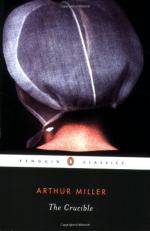|
This section contains 828 words (approx. 3 pages at 300 words per page) |

|
Destroyed but not Defeated: "The Crucible and "The Old Man and the Sea"
Summary: In "The Old Man and the Sea" by Ernest Hemingway and "The Crucible" by Aruthur Miller, the main character are "destroyed but not defeated," in Hemingway's words. The men in these two classic words break under the demands of the obstacles in their way, but they persevere and refuse to be demoralized.
"A man may be destroyed but he is not defeated"
Destroyed and defeated are two very powerful words. However, not all that is destroyed is defeated. The quote "A man may be destroyed but not defeated," by Ernest Hemingway implies that a man can be damaged but not crushed. This statement is accurate; no matter how many obstacles a man may face in his life there is no one challenge that can triumph over man. The Old Man and the Sea by Ernest Hemingway and The Crucible by Arthur Miller each have a character that is destroyed but not defeated. In The Old Man and the Sea Santiago is impaired however not broken, in The Crucible John Proctor is annihilated but not ruined.
In the Old Man and the Sea by Ernest Hemingway Santiago is completely destroyed however he is not defeated. Santiago is characterized as determined, skillful, confident and unlucky. However looks are deceiving. Santiago is extremely...
|
This section contains 828 words (approx. 3 pages at 300 words per page) |

|


